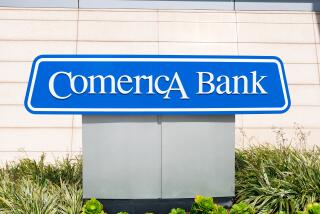S&Ls;’ Ink Gets Redder, Banks’ Gets Blacker
- Share via
WASHINGTON — U.S. savings institutions had losses of $3.4 billion in the first three months of this year, in sharp contrast to record profits of $7.3 billion posted by commercial banks, the government reported Tuesday.
Texas savings and loans, suffering from a depressed regional economy, once again accounted for the bulk of the S&Ls;’ deficit, as their first-quarter losses totaled $2.2 billion--but that was a 38% improvement from the same period in 1988.
Nationally, 73% of S&Ls; were profitable, earning a combined $1.3 billion. But that was swamped by $4.7 billion in losses at the other 27%. According to the Federal Home Loan Bank Board, the losses at those 2,938 institutions worsened from a revised $3.2 billion in the final three months of 1988.
Meanwhile, profits at the 13,001 commercial banks set a record for the third consecutive quarter, up from $6.7 billion in the final three months of last year.
The bank board revised its previously reported S&L; loss total for all of last year, adding $900 million to bring the 1988 red ink to a post-Depression record of $13 billion.
“The thrift industry will be plagued by continuing losses,” said economist Paul Getman of WEFA Group, a Bala-Cynwyd, Pa., consulting firm. “Not only are property values in some areas still falling, but thrifts have been squeezed (because) their cost of funds has been rising faster than their mortgage rates.”
10 Losing Money
James R. Barth, chief economist of the bank board, said heavy S&L; losses will continue until Congress enacts President Bush’s bailout bill.
“No legislation, no new funds, is not the best way to deal with open but insolvent institutions,” he said.
Barth said the more than 200 institutions rescued last year with government assistance contributed $145 million in profits. But, he said, about 10 of those institutions were losing money.
Reporting on commercial banks, the Federal Deposit Insurance Corp. said profits rose in 42 states and the District of Columbia and declined in eight states and Puerto Rico. New England, in particular, looked weaker, with profits slipping in Massachusetts, Connecticut and Maine.
Alex Sheshunoff, a financial industry analyst in Austin, Tex., said he was concerned that banks have increased their real estate lending by 12.9% from a year ago while boosting commercial lending by only 1.4%.
“Real estate lending has been the Achilles’ heel of the banking industry. We’re beginning to see that deteriorate in the Northeast,” he said.
Only one state, Texas, reported a loss for its banks, and its $13-million deficit was minuscule when compared to a $1.7-billion net loss in the same 1988 quarter. Other oil-producing states such as Alaska, Oklahoma and Louisiana also showed big improvements.
John Quinn, an FDIC analyst, attributed commercial banking’s strong performance to a decline in bad loans, particularly in states west of the Mississippi River, an increase in loan income caused by rising interest rates and success in controlling expenses.
Unlike S&Ls;, banks offer mostly short-term loans and can more quickly raise interest rates they charge while still holding down the rates they pay to depositors. Compared to S&Ls;, banks are hurt less--and sometimes are helped--by rising interest rates.
Quinn said bad loans have declined in farming states in particular, where he said institutions so far have generally not suffered financially from last year’s drought.
But despite record profits, banks continued to fail at a high rate. The FDIC, which insures deposits, said 93 banks have failed or required government assistance so far this year, compared to 89 in the same period of 1988. For all of last year, a post-Depression record of 221 failed.
However, the number of “problem banks” has slipped to 1,289, the lowest three years, from 1,491 a year ago.
Despite the failures last year, banks posted record profits of $25.1 billion. That followed a post-Depression profit low of $2.8 billion in 1987, caused by large writeoffs of Third World debt.
Getman said Argentina’s current inability to make payments on its $60-billion foreign debt probably will begin hurting bank performance in the second and third quarters.
“Obviously, bank profits are very good, but they’re not likely to stay that good this year,” he said.
More to Read
Inside the business of entertainment
The Wide Shot brings you news, analysis and insights on everything from streaming wars to production — and what it all means for the future.
You may occasionally receive promotional content from the Los Angeles Times.









